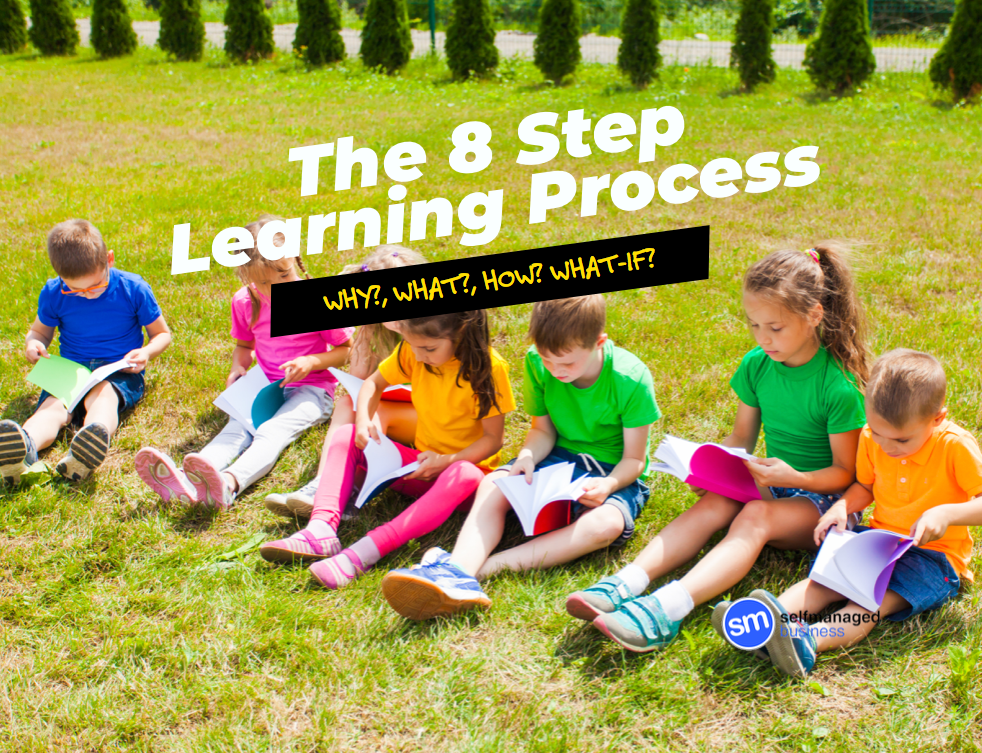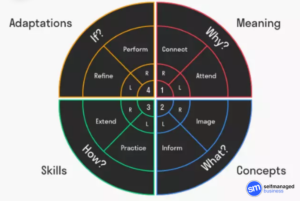What are the 4 Models of Learning?

The 4MAT Learning Cycle Model was developed and published by Bernice McCarthy in 1980. She came up with the idea when she worked as a kindergarten teacher in the 1970s.
She researched how children learned and created her theory by combining Kolb’s model of learning styles and the concept of the two brain halves that process information in a different way and her own practical knowledge.
According to McCarthy, there are four learning styles however most people seem to favor one particular type. The model is constructed along two continuum’s: observing and processing.
- Observing – the ways people take in new information
- Processing – what people do with new information.
A person’s individual preference along these continuums determines his or her individual approach to learning.
The result is an 8-step sequential instruction model that is made up of four quadrants each representing the four learning styles.
The 8-step learning process
The 4MAT Learning Styles Model has four phases in a learning cycle.
Every learning style is determined by the way the left and right halves of the brain function, which means that every quadrant has a left and right mode. The left half prefers structure and order, language and numbers and works to analyse information. The right half includes visualisation, images, searches for patterns and creates metaphors.
The complete learning cycle consists of 8 steps from the four quadrants.

Note: Read the model clockwise:
Quadrant 1: WHY?
1.1: Connect
The reason why something should be learned is created, the answer to the question ‘why?’.
This makes use of the ‘right mode’ of the brain. The goal is to have the learner experience it for themselves by getting them involved. This can be done, for example, by having the learner share his or her own experiences.
1.2: Attend
Learners examine the experience. The method involves a discussion, but this time students are asked to look past their own experience.
The goals of the WHY quadrant are: giving meaning to the subject, visualising and allowing the student to integrate aspects of the subject.
Quadrant 2: What?
2.1: image
In this step, an attempt is made to make the learner reflect more deeply. A good coach is able to move the learner from the concrete to the abstract. This allows a learner to form a picture of the subject material, which makes them reinforce their focus.
Quadrant 2.2: inform
The coach takes the learner to the core of the conceptual information. This is about taking in information.
The information that you choose to share should be based on the concept and shared experiences, and should lead to further research by the learner.
The goals in quadrant two are conceptualising, defining, shaping and acquiring knowledge.
How to Increase Your Flow of Leads without Paying for Ads?
As an online business coach, it seems like you’ve got 2 options to generate leads: Pay for expensive ads, or post organic content and hope you get there … slowly…there’s a better way…
Click here to access the FREE “Steady Flow of Leads” training
Quadrant 3: How
Quadrant 3.1: practice
In the third quadrant the ‘how’ question is answered. In this step, students actively get started with the knowledge gained from the previous steps from the left mode. They will use worksheets, run experiments or use related technology.
Quadrant 3.2: extend
The learner will make their own contribution to the teaching material. This may be a personal synthesis.
The common sense learners (refer to styles below) , feel most at ease here.
The goals of quadrant three include collecting data, asking questions, hypothesising, tinkering, experimenting and making decisions.
Quadrant 4: What if?
Quadrant 4.1: refine
The ‘what if’ question, or as I like to put it ‘What next?’ will be answered.
In this step, the learner is asked to analyse what they’ve planned as an addition to what they’ve learned from the previous step.
Quadrant 4.2: perform
In the final step the learner explains to what they have learned or created. It’s also important in this step that the students are asked to talk about what they’ve learned and gained from this entire cycle.
The goals in the fourth quadrant are: identify limitations, review, close, summarise and evaluate.
The learning styles in the 4MAT Learning Cycle Model
Although every person prefers a particular learning style, according to Bernice McCarthy’s 4MAT model, every learner goes through the entire process mentioned above. There is a difference in the learning styles of the four types of learners, each asks a different question about the information they have gained.
The four types of learners are:
The imaginative learner
The imaginative type of learner likes to engage in feelings and spend time on reflection.
This type of learner desires personal meaning and involvement.
Favourite question: why should I learn this?
Analytical learner
The analytical type of learner likes to listen, to think about information and to come up with ideas.
This type is interested in acquiring facts and delving into concepts and processes. They can learn effectively and enjoy doing independent research.
Favourite question: what should I learn?
Common sense learner
The common sense learner type likes thinking and doing.
This type likes tinkering and applying useful ideas.
Favourite question: how should I learn?
Dynamic learner
The dynamic type of learner loves doing and feeling. This type is continually looking for hidden possibilities and researching ideas to make original adjustments. They learn through trial and error and self-discovery.
Favourite question is: what if I learn this?
Thanks for reading.
P.S. WHENEVER YOU'RE READY...
Here Are 4 Ways I Can Help You
And Your Coaching Business Right Now!
Previous
Next






